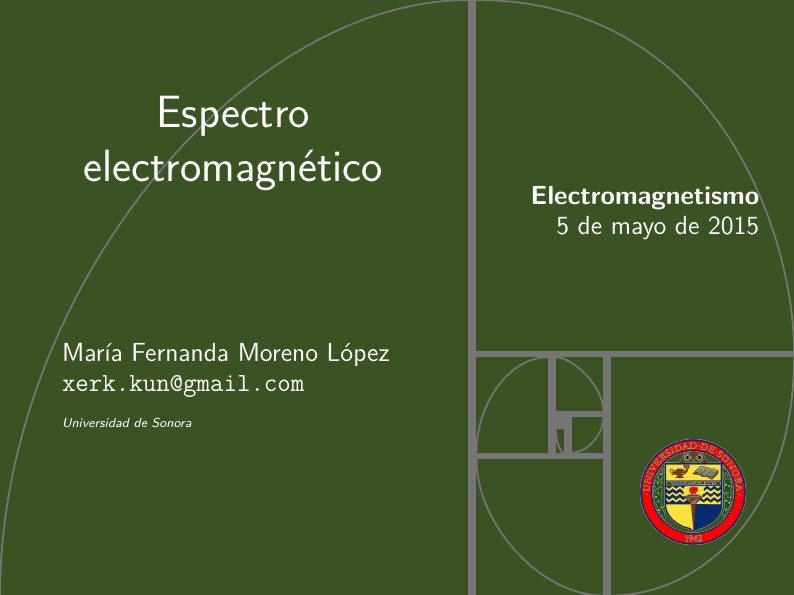
Espectro electromagnético
作者:
Fer Moreno
最近上传:
11 年前
许可:
Creative Commons CC BY 4.0
摘要:
Beamer theme "Cuerna", version 1.0 Copyright Gubertino Cavalieri (mathsguy@bluesimplex.com) October 2014. distributed under the GNU GPL Licence.

Beamer theme "Cuerna", version 1.0 Copyright Gubertino Cavalieri (mathsguy@bluesimplex.com) October 2014. distributed under the GNU GPL Licence.

%%Beamer theme "Cuerna", version 1.0
%%Copyright Gubertino Cavalieri (mathsguy@bluesimplex.com)
%%October 2014. distributed under the GNU GPL Licence.
\documentclass{beamer}
\usepackage[utf8]{inputenc}
\usepackage[T1]{fontenc}
\usepackage[spanish]{babel}
\usepackage{graphicx}
\usepackage{comment}
\AtBeginSubsection[] {
%Tabla de contenido de la presentación
\begin{frame}<beamer>
\tableofcontents[currentsection,currentsubsection]
\end{frame}
}
%%Defining the ``proposition'' environment
\newtheorem{proposition}{Proposition}
%%Sets the beamer theme "Cuerna"
\usetheme{Cuerna}
\usecolortheme{lettuce}
%Available color themes: default, bluesimplex, brick, lettuce
%%Insert the logo
\logo{\includegraphics[width=1.7cm]{logo.png}}
%%Title
\title{Espectro electromagnético
}
\author{María Fernanda Moreno López\\ %Author
\texttt{xerk.kun@gmail.com}} %e-mail
\date{\textbf{Electromagnetismo}\\
\today} %Date or event
\institute{Universidad de Sonora} %%Institution
\begin{document}
\begin{frame}
\titlepage %Creates the title page
\end{frame}
%--------------------------------------------------------------------------
\begin{frame}{Contenido}
\tableofcontents %Prints the table of contents
\end{frame}
%--------------------------------------------------------------------------
\section{Introducción} %%A section (Optional)
\subsection{Etimología y origen}
\begin{frame}{Etimología y origen}
\begin{itemize}
\item [\checkmark] Proviene del latin \textit{espectrum} y significa \textit{forma} o \textit{aspecto}.
\begin{figure}[H]
\centering
\includegraphics[width=.75\textwidth]{prisma-de-newton.jpg}
\caption{\label{fig:figura1}\textit{Prisma de Newton}}
\end{figure}
\end{itemize}
\end{frame}
\subsection{Definición}
\begin{frame}{Definición}
\begin{figure}[H]
\centering
\includegraphics[width=1\textwidth]{Espectro-Electromagnetico.jpg}
\caption{\label{fig:figura1}\textit{Espectro electromagnético}: Clases de radiacion clasificadas por frecuencia o longitud de onda.}
\end{figure}
\end{frame}
\section{Algunas clases}
\subsection{Luz}
\begin{frame}{Luz}
\begin{itemize}
\item \textbf{Región visible del espectro, emitida por:}
\item [\checkmark] Átomos disgregados (un gas)
\item [\checkmark] Átomos individuales o por un grupo de estos (un sólido)
\item \textbf{Aplicaciones:}
\item [\checkmark] Brinda información sobre la composición química, temperatura y movimiento de las estrellas.
\end{itemize}
\end{frame}
\begin{frame}{Luz}
\begin{figure}[H]
\centering
\includegraphics[width=1\textwidth]{LuzVisible.jpg}
\end{figure}
\end{frame}
\begin{frame}{Luz}
\begin{figure}[H]
\centering
\includegraphics[width=.85\textwidth]{allsky_mellinger_c2.jpg}
\caption{\label{fig:figura1}Imagen de luz visible de la Vía Láctea.(Axel Mellinger)}
\end{figure}
\end{frame}
\subsection{Rayos infrarrojos}
\begin{frame}{Rayos infrarrojos}
\begin{itemize}
\item \textbf{ Radiación de calor}:
\item [\checkmark] Relacionada con la transferencia de calor por la ganancia o pérdida de energía interna.
\item [\checkmark] Emitida por átomos o moléculas al modificar su movimiento rotacional o vibratorio.
\item \textbf{Aplicaciones:}
\item [\checkmark] Complementa la información que emite la luz visible del espacio.
\end{itemize}
\end{frame}
\begin{frame}{Rayos infrarrojos}
\begin{figure}[H]
\centering
\includegraphics[width=.85\textwidth]{via-lactea_infrarrojo_cobe.jpg}
\caption{\label{fig:figura1}Imagen infrarroja de la Vía Láctea. (DIRBE Team, COBE, NASA)}
\end{figure}
\end{frame}
\subsection{Microondas}
\begin{frame}{Microondas}
\begin{itemize}
\item \textbf{Producidas por circuitos eléctricos oscilantes}:
\item [\checkmark] Hornos de microondas
\item \textbf{Aplicaciones}
\item [\checkmark] Retransmitir llamadas telefónicas
\item La radiación residual emitida por el "Big Bang" se produce en la región microondas del espectro.
\end{itemize}
\end{frame}
\begin{frame}{Microondas}
\begin{figure}[H]
\centering
\includegraphics[width=.85\textwidth]{microondas_planck.jpg}
\caption{\label{fig:figura1}Imagen de ondas de microondas de la Vía Láctea.(The Planck)}
\end{figure}
\end{frame}
\subsection{Ondas de radio}
\begin{frame}{Ondas de radio}
\begin{itemize}
\item \textbf{Producidas por:}
\item [\checkmark] Los electrones que oscilan en los alambres de circuitos eléctricos
\item [\checkmark] Fuentes extraterrestres como el Sol y Júpiter.
\item \textbf{Aplicaciones}
\item [\checkmark] Medios de comunicación como la radio y la televisión.
\item [\checkmark] Información del Universo.
\end{itemize}
\end{frame}
\begin{frame}{Ondas de radio}
\begin{figure}[H]
\centering
\includegraphics[width=.9\textwidth]{Picture31.jpg}
\caption{\label{fig:figura1}Imagen de radio de la Vía Láctea.(C. Haslam et al., MPIfR, SkyView)}
\end{figure}
\end{frame}
\section*{Bibliografía}
\begin{frame}{Bibliografía}
\begin{itemize}
\item Resnick, Halliday, Krane. \textit{Física Vol. 2}, 5ta ed.
\item \textit{Multiwavelength astronomy}\\
ipac.caltech.edu/outreach/Multiwave/gallery3.html
\item \textit{Radio astronomy}\\
skatelescope.org/radio-astronomy/
\item \textit{Dark matter hope fades in microwave haze}\\
physicsworld.com/cws/article/news/2012/sep/10/dark-matter-hope-fades-in-microwave-haze
\end{itemize}
\end{frame}
\end{document}